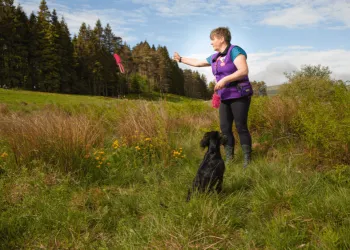
Wondering about your dog's prey drive?
Take the quiz that’s helped thousands of dog owners understand what’s going on with their dog.
I’ll be upfront: there’s nothing you can do at home — or anywhere else — to erase your dog’s prey drive. Their chasing instincts are part of who they are, and many dogs have been carefully bred to have a high prey drive - yours could be one of them.
The good news is that there is loads you can do at home that will make your dog’s prey drive cause you way fewer problems.
Once you understand what to do and are better set up, you might even find that you save a fortune in enrichment toys. The great thing about high prey drive dogs is that once you understand them better, you’ll find that the outside world — including your garden — can be one massive enrichment opportunity for your dog.
Spend the next week or so watching what happens at home and making notes. It is hard to fix issues when you don’t know exactly what is going on. More than that, memory isn’t a perfect recording.
Combat that by becoming a detective in your own home.
Note down everything your dog does each day. To make your notes targeted and helpful for managing prey drive, focus on the times when your dog gets excited. Make a note of what happens before the excitement, what causes them to be excited and what happens afterwards.
For instance, when you get up to make a drink, your dog may run to the back door and stand there, looking alert. You open the door for them. They run outside to bark at squirrels or chase birds in the garden. If anything like that happens in your dog’s life, note it down.
At the end of the week, you’ll have a great idea of all the times when your dog gets excited. Not all of them will be about prey, but many will give you clues about where to make changes at home to help your dog handle it better.
A really common example of this is when it’s time for a walk. All those little signs that a walk is coming can wind some dogs up so much that, by the time you get outside, they’re already primed to chase the first thing they see. This is one reason many people feel their dog won’t listen outside — they’re already over-excited before the training begins.
One of the biggest things you can do to help yourself out with prey chasing problems is to remember that your dog is always developing habits and learning. While prey drive is instinctive to your dog, how they respond to prey is shaped by habit and experience.
That means one of your biggest opportunities to save yourself the stress of dog chasing behaviour is to take control and help your dog learn the right things at home.
Be present with your dog if they might have access to prey at home. That means going outside with them if there are birds or squirrels in your garden - or flying overhead! If you have cats or other pets, keep them separate when you’re not supervising. Otherwise, your dog may build habits of chasing or fixating on them.
If you want your dog to stay calm when they see squirrels, it’s important they don’t spend hours barking out the window. If you want to stop them chasing birds for miles, don’t leave them outside alone, reinforcing those habits.
Instead, become a ninja at spotting problem habits and preventing them. Window film or rearranging furniture can help with windows. Food scatters in the garden can take attention off the wildlife. It doesn’t have to be perfect. Nobody is perfect. Just consistent. Habits form with consistency - and the more you prevent rehearsals of chasing instincts, the easier it becomes to build calmer behaviours.
If you take nothing else from reading this, take the knowledge that your dog’s prey drive isn’t the enemy - any more than their need for food or water is the enemy. Their prey drive is part of who your dog is and they absolutely need outlets for prey drive.
You may have heard that giving outlets makes prey drive worse. That’s nonsense.
In fact, prey drive, like any other instinctive behaviour, gets stronger without outlets. Denying your dog structured ways to use it only builds frustration and intensity. The key is to redirect prey drive into safe, structured activities.
You need to be strategic about giving outlets. And don’t worry - there is absolutely no need to let your dog run wild in the countryside chasing anything that moves. You can provide safe outlets at home, in your garden, or through games.
I cover outlet ideas here: Safe outlets for prey drive.
Another great thing you can do at home is teach your dog impulse control - even around prey.
Wild predators survive by waiting for the right moment to chase. Your dog doesn’t need wolf-level patience, but they can learn that not everything must be chased immediately.
A simple place to start is the door. Many dogs bolt out the door because excitement takes over. Put a lead on, begin to open the door, and if your dog rushes forward, calmly guide them back. Don’t get angry - they don’t know yet what to do. Just reset and try again. At first you may only get as far as touching the handle before they move. That’s fine. Reward even a second of stillness, then release them with food, a toy, or the chance to go outside - whatever motivates them most.
Over time, build up until you can fully open the door and your dog waits calmly until you release them. If you stay consistent, you’ll end up with a dog who has better self-control around prey drive triggers and a habit of looking to you for guidance instead of bolting.
One of the biggest challenges with training dogs is remembering to practice. If your dog knows some training, make sure you practice it often at home and when you are out walking on the lead too. Don’t save all your recall training for the difficult times when a squirrel suddenly appears.
Training only sticks if you practice it often.
Think about it like this: if the only time you call your dog is when he has taken off in pursuit of a squirrel, he’s not likely to respond. It may be that you are reading this blog because you’ve found that to be the case.
The change to make is to practice calling your dog several times every day. Do it at home, in your garden, on the lead, and when there are no distractions around. That way you massively increase the chance of a solid recall for prey drive dogs when there are squirrels or birds around.
Learning is stressful. So is changing habits. And yes - doing things differently is stressful too!
When you are making changes to your daily routines, take the time to notice your efforts, congratulate yourself and find ways to build in rewards for the work you’re doing.
Consistency is everything when it comes to managing high prey drive dogs - but it’s much easier to stay consistent if you also reward yourself for the effort.
While it isn’t possible to reduce your dog’s prey drive, what you do at home can make a huge difference to life with a high prey drive dog. With consistent practice, smart management, and safe outlets, you can turn a source of stress into something rewarding for both you and your dog.

Take the quiz that’s helped thousands of dog owners understand what’s going on with their dog.
Spend a week tracking excitement spikes: what happens before, during and after. Patterns reveal where to change routines.
No. Supervise, manage windows, and avoid unsupervised garden time that rehearses chasing and barking.
No. Without outlets, it tends to get stronger. Provide safe, structured games to channel it.
Yes. Door manners are a great start: reward stillness, then calmly release.
Daily. Rehearse recall and calm behaviour in easy contexts so it works when wildlife appears.
McLennan, T., 2023. Does the attention a dog pays to their owner increase after the dog engages in activities that mimic the predatory preferences of that dog (Canis familiaris)? Applied Animal Behaviour Science, 263. DOI: https://doi.org/10.1016/j.applanim.2023.105944
McLennan, T., 2023. Review of literature on interventions aimed at resolving problems caused by predatory behaviour in dogs (Canis familiaris). Applied Animal Behaviour Science, 264. DOI: https://doi.org/10.1016/j.applanim.2023.106037

These are the emails you’ll actually look forward to.
No fluff. Just the best insights, strategies, and stories about high prey drive dogs that you won’t find anywhere else. Join thousands of owners who rely on my emails every week – and never miss out.

I’ve lived with high prey drive dogs for over 20 years, and I know first-hand how challenging and rewarding they can be.
I back up that hands-on experience with academic study: a BSc (Hons) in Canine Behaviour and Training and a Master’s degree with distinction in Applied Animal Behaviour and Training. I also hold an MA (Hons) in Philosophy, which shapes the ethical approach behind all my work.
Alongside working with thousands of owners of high prey drive dogs, I’ve contributed to the science too:
My mission is simple: to show you that life with a high prey drive dog doesn’t have to be a battle — it can be fun, fascinating, and full of success.
👉 Want help right now? Start with my free Prey Drive Course — it’s the easiest way to begin.
If you’re ready to go further, you can also work with me 1-to-1, join the High Prey Drive Club, or explore my Masterclass Series.